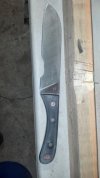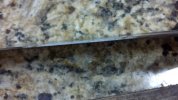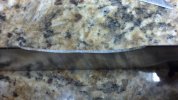J. Hoffman
Knifemaker / Craftsman / Service Provider
- Joined
- Jan 1, 2011
- Messages
- 1,784
I just finished this chopper for myself. I planned on using this for work. It's 1095 with micarta, nickel corbys and copper tubes. I put a nice convex edge on it, and took it to a 2x4 to see how well this chopper actually chops. Well, you can see the results. After about 6 chops I ended up with two big chips missing. I think the grain is pretty course, but I guess I don't have anything to compare it to. I have a kiln coming, along with some Parks 50 so I hope this issue will not rear it's ugly head again. Can anyone tell me what the likely issue was? Any and all info is appreciated.




